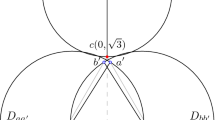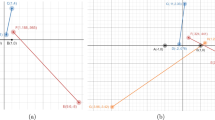Abstract
A matching is compatible to two or more labeled point sets of size n with labels \(\{1,\dots ,n\}\) if its straight-line drawing on each of these point sets is crossing-free. We study the maximum number of edges in a matching compatible to two or more labeled point sets in general position in the plane. We show that for any two labeled convex sets of n points there exists a compatible matching with \(\lfloor \sqrt{2n}\rfloor \) edges. More generally, for any \(\ell \) labeled point sets we construct compatible matchings of size \(\varOmega (n^{1/\ell })\). As a corresponding upper bound, we use probabilistic arguments to show that for any \(\ell \) given sets of n points there exists a labeling of each set such that the largest compatible matching has \(\mathcal {O}(n^{2/(\ell +1)})\) edges. Finally, we show that \(\varTheta (\log n)\) copies of any set of n points are necessary and sufficient for the existence of a labeling such that any compatible matching consists only of a single edge.
A.A. funded by the Marie Skłodowska-Curie grant agreement No. 754411. Z.M. partially funded by Wittgenstein Prize, Austrian Science Fund (FWF), grant no. Z 342-N31. I.P., D.P., and B.V. partially supported by FWF within the collaborative DACH project Arrangements and Drawings as FWF project I 3340-N35. A.P. supported by a Schrödinger fellowship of the FWF: J-3847-N35. J.T. partially supported by ERC Start grant no. (279307: Graph Games), FWF grant no. P23499-N23 and S11407-N23 (RiSE).
Access this chapter
Tax calculation will be finalised at checkout
Purchases are for personal use only
Similar content being viewed by others
Notes
- 1.
The combinatorial embedding fixes the cyclic order of incident edges for each vertex.
- 2.
https://www.imo-official.org/problems/IMO2017SL.pdf, Problem C4.
- 3.
Two edges are independent if they do not share an endpoint.
References
Ábrego, B.M., Fernández-Merchant, S., Leaños, J., Salazar, G.: A central approach to bound the number of crossings in a generalized configuration. In: LAGOS2007, pp. 273–278. ENDM (2007)
Ábrego, B.M., Fernández-Merchant, S., Salazar, G.: The rectilinear crossing number of \({K}_n\): closing in (or are we?). In: Pach, J. (ed.) Thirty Essays on Geometric Graph Theory, pp. 5–18. Springer (2013). https://doi.org/10.1007/978-1-4614-0110-0_2
Aichholzer, O., Aurenhammer, F., Hurtado, F., Krasser, H.: Towards compatible triangulations. TCS 296(1), 3–13 (2003)
Aichholzer, O., Barba, L., Hackl, T., Pilz, A., Vogtenhuber, B.: Linear transformation distance for bichromatic matchings. CGTA 68, 77–88 (2018)
Aichholzer, O., et al.: Compatible geometric matchings. CGTA 42(6–7), 617–626 (2009)
Aichholzer, O., Duque, F., Fabila-Monroy, R., Hidalgo-Toscano, C., García-Quintero, O.E.: An ongoing project to improve the rectilinear and the pseudolinear crossing constants. ArXiv e-Prints (2020)
Alamdari, S., et al.: How to morph planar graph drawings. SIAM J. Comput. 46(2), 824–852 (2017)
Aloupis, G., Barba, L., Langerman, S., Souvaine, D.: Bichromatic compatible matchings. CGTA 48(8), 622–633 (2015)
Aronov, B., Seidel, R., Souvaine, D.: On compatible triangulations of simple polygons. CGTA 3, 27–35 (1993)
Arseneva, E., et al.: Compatible paths on labelled point sets. In: CCCG 2018, pp. 54–60 (2020)
Babikov, M., Souvaine, D.L., Wenger, R.: Constructing piecewise linear homeomorphisms of polygons with holes. In: CCCG 1997 (1997)
Baxter III, W.V., Barla, P., Anjyo, K.: Compatible embedding for 2D shape animation. IEEE Trans. Vis. Comput. Graph. 15(5), 867–879 (2009)
Berlekamp, E.R., Conway, J.H., Guy, R.K.: Winning ways for your mathematical plays, vol. 1, 2 edn. A. K. Peters Ltd. (2001)
Czabarka, É., Wang, Z.: Erdő-Szekeres theorem for cyclic permutations. Involve J. Math. 12(2), 351–360 (2019)
Czyzowicz, J., Kranakis, E., Krizanc, D., Urrutia, J.: Maximal length common non-intersecting paths. In: CCCG 1996, pp. 185–189 (1996)
Erten, C., Kobourov, S.G., Pitta, C.: Intersection-free morphing of planar graphs. In: Liotta, G. (ed.) GD 2003. LNCS, vol. 2912, pp. 320–331. Springer, Heidelberg (2004). https://doi.org/10.1007/978-3-540-24595-7_30
Floater, M.S., Gotsman, C.: How to morph tilings injectively. JCAM 101, 117–129 (1999)
Hui, P., Schaefer, M.: Paired pointset traversal. In: Fleischer, R., Trippen, G. (eds.) ISAAC 2004. LNCS, vol. 3341, pp. 534–544. Springer, Heidelberg (2004). https://doi.org/10.1007/978-3-540-30551-4_47
Ishaque, M., Souvaine, D.L., Tóth, C.D.: Disjoint compatible geometric matchings. DCG 49, 89–131 (2013)
Krasser, H.: Kompatible Triangulierungen ebener Punktmengen. Master’s thesis, Graz University of Technology (1999)
Pach, J., Shahrokhi, F., Szegedy, M.: Applications of the crossing number. Algorithmica 16(1), 111–117 (1996)
Saalfeld, A.: Joint triangulations and triangulation maps. In: SoCG 1987, pp. 195–204 (1987)
Sharir, M., Sheffer, A.: Counting triangulations of planar point sets. E-JC18(1) (2011)
Sharir, M., Sheffer, A., Welzl, E.: Counting plane graphs: perfect matchings, spanning cycles, and Kasteleyn’s technique. JCTA 120(4), 777–794 (2013)
Author information
Authors and Affiliations
Corresponding author
Editor information
Editors and Affiliations
Rights and permissions
Copyright information
© 2021 Springer Nature Switzerland AG
About this paper
Cite this paper
Aichholzer, O. et al. (2021). On Compatible Matchings. In: Uehara, R., Hong, SH., Nandy, S.C. (eds) WALCOM: Algorithms and Computation. WALCOM 2021. Lecture Notes in Computer Science(), vol 12635. Springer, Cham. https://doi.org/10.1007/978-3-030-68211-8_18
Download citation
DOI: https://doi.org/10.1007/978-3-030-68211-8_18
Published:
Publisher Name: Springer, Cham
Print ISBN: 978-3-030-68210-1
Online ISBN: 978-3-030-68211-8
eBook Packages: Computer ScienceComputer Science (R0)




